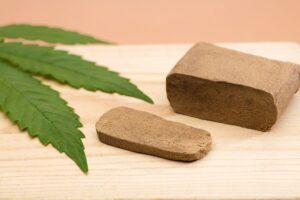Differences Between Hash & Cannabis: Hashish 101
With the rapidly expanding hemp and cannabis markets, there has never been a wider variety of cannabis extracts available to consumers than present day. Each has their origins and qualities that would make them preferred over others. However, none quite compare to hash, also known as hashish.
Hash has been around for centuries and has a significant cultural aspect. Today, our experts are delving into its origins, effects, how people made it, and how hash compares to other cannabis products.
What is Hash?
Hash is a cannabis extract, that’s made after removing and processing trichomes, the resinous glands that line the surface of cannabis plants, into a concentrated form. It is usually dark or brown-green in color and shaped into a brick or a ball.
Hash is also a solventless extract since solvents and chemicals aren’t used in trichome removal. Instead, physical manipulation and temperature changes are applied to produce the finished product.
There are a few different types of hash, separated by the processes involved in its making.
Hashish Origins
Hashish has deep-seated roots that span over several centuries. It originates from regions such as the Middle East, North Africa, and India. While there is no exact year of origin, literature on the topic dates as far back as 1123 CE. For a long time, the Middle East and India were the primary producers of hash, primarily exporting the product to Europe.
However, in the 1960s, Morocco started massive production of hash for international trade, as cannabis was widely available. Many producers call it Moroccan Hash because of the country’s monopoly on the product. However, most times it didn’t come from Morocco.
Subjective Effects
The concentrated cannabinoids in hash have been known to produce powerful feelings of euphoria and relaxation. As a refined form of cannabis, hash is known to be much stronger than cannabis flower – it’s sought after for that very reason.
Leafy8 produces a variety of hash that’s made with HHC, a cannabinoid many claim produces less anxiety and paranoia. They also produce a pre-rolled hash cone, each containing around 1/4 gram of hash. It is important to remember these products are concentrated; it’s easy to go overboard and take too much.
A wise course of action would be to start with a small amount and wait for about an hour before deciding whether to take more or not. Typically users can feel the effects of Hash within 15 minutes after smoking and 30-60 minutes when eaten.
Some of the short-term effects of hash include:
- changes in perception; including feelings of relaxation or pleasure
- reduced short-term memory
- increased appetite
- altered feeling in the senses (the ability to see colors, hear sounds, and taste food more clearly)
- altered sense of time and space (feeling that time is slow and the distances are longer)
- dry mouth and throat (“cottonmouth”)
- impaired motor skills
- cognitive impairment, including poor reactions
- blood-shot eyes
Hash vs. Flower
When many hear about hash for the first time, they commonly ask “Well, how does it compare to flower?” It’s a fair question, as hash derives from flower. Generally, Hash is more concentrated than cannabis flower, which can lead to a much more powerful experience.
Hash contains between 40-80% THC, depending on how it’s prepared, while most flower falls in the 15-25% range. In addition, it is important to remember that cannabinoids can affect everyone differently – what works best for one person may not necessarily hold true for another.

Leafy8’s Moroccan Hashish during production
Hashish Production Methods
Hashish is derived from trichomes on the cannabis or hemp plant. Trichomes contain the highest concentration of cannabinoids on the plants. Hash is simple and easy to make. Several methods can be done at home safely and with minimal supplies.
Most other concentrates require expensive equipment. Additionally, they need to be made by legal, licensed technicians in a controlled environment. However, anyone can make hash. One of the easiest types of hash to produce yourself is called “dry sift hash”, which is essentially a refined form of kief.
To create dry sift, or dry sieve hash, extractors rub, roll, and tumble dried cannabis over a finely woven mesh screen. This agitation breaks off dried resin glands from the plant matter, allowing the trichome heads to pass through the screen.
Extractors often repeat this process through a series of finer and finer meshes to refine the hash further. They often use powdery resin to top a bowl or sprinkle it into a joint to add potency. Others prefer to press it into traditional hash or rosin to dab.
How To Make Homemade Hash
Here is a step-by-step guide to making dry sift hash in a household setting that requires only minimal equipment and experience:
WHAT YOU WILL NEED:
- Plenty of dried and well-cured cannabis (1 ounce or more recommended)
- Wooden sifter box
- Object for scraping (playing cards, credit card, piece of wood, etc.)
- Pollen press (hash press)
- Small funnel or sheet of paper (so you can more easily fill the press with kief)
- Large grinder, trimming shears, etc. (optional, for breaking up your dry weed)
INSTRUCTIONS:
- Open the sifter box. Take a generous amount of dry cannabis and evenly spread it out on the screen. The amount of weed used here will depend on the size of the sifter box.
- Close the top lid of the sifter box.
- Shake the flower in the box for a few minutes. With some DIY sifters, such as those where the flower is situated beneath a flexible cover, you can “card it” by swiping a credit card across it to break the bud down. Card it gently for 10–15 minutes (depending on the amount of weed).
- Open the sifter box mix the now broken-down weed well, and spread it out again for a second run.
- Repeat for a third round of shaking, carding, and rubbing.
- Open the sifter box and remove the screen with the now-depleted weed on it. Underneath the sifter, lots of fine kief powder should have been collected.
- Scrape the kief powder into a nice pile. There should be a handful of pure trichome goodness!
HOW TO PRESS KIEF POWDER INTO HASH:
- Open the pollen press and fill it up with kief. You can use a small funnel or carefully fill it manually. Don’t overfill it.
- Screw the top part with the handle back onto the pollen press.
- Using the handle on the pollen press, screw down tightly (until you no longer can) to firmly press the powder.
- Open the pollen press at the bottom by removing the lower part. Now, crank the press a few more times, and out comes a nice, tightly pressed cylinder of hash!
Conclusion
The cannabis community regards Hashish as a timeless and revered product. Its long-seated history, unique effects, production method, and how it stacks against other products contribute to its reputation.
Whether you enjoy hash in a traditional setting or as part of a more modern scene, hashish continues to add to the rich culture of cannabis. This compound invites enthusiasts to take a step into the past and embrace the possibilities out there.
New deals and discounts are always in the works – stay tuned to our Instagram or join our mailing list to be among the first to claim our latest sales and new product drops! Our newsletter signup is at the bottom of every page on our website.
Leafy8 – Casselberry
222 Wilshire Blvd
Casselberry, FL 32707
Leafy8 – Orlando/Winter Park
7414 University Blvd, Suite #104
Winter Park, FL 32792
Facebook: @Leafy8
Instagram: @got_that_leafy
Phone: (855)-453-2398
Email: info@leafy8.com
More information on franchising opportunities to come soon!
Wholesale and Private Label options are available upon request.
#gotthatleafy
*These statements have not been evaluated by the FDA. These products are not intended to diagnose, treat, cure, or prevent any disease.



